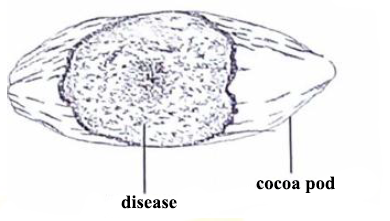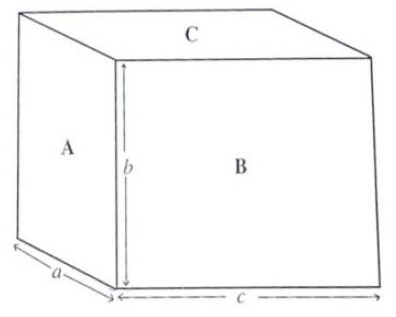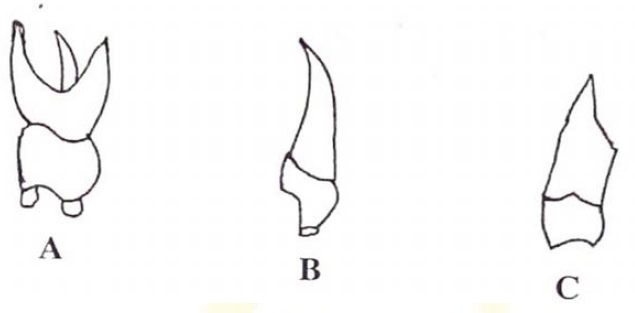1.
Brass is an alloy of
iron and carbon
zinc and copper
iron and copper
copper and tin
2.
An example of inorganic fertilizer is
ammonium nitrate.
cow dung.
farmyard manure.
poultry dropping.
3.
The component of the human blood which transport oxygen to all parts of the body
plasma.
platelets.
red blood cells.
white blood cells.
4.
The importance of fuse in an electrical circuit is to
regulate the voltage.
prevent damage to electrical appliances.
alter the flow of current in the circuit.
minimize the use of current.
5.
Which of the following step(s) is/are required in the scientific method?
I. Formulation of hypothesis
II. Identification of the problem
III. Experimentation
I only
II only
II and III only
I, II and III
6.
Which of the following food items produces amino acids as end-product of digestion?
Cabbage
Fish
Margarine
Rice
7.
The process of increasing the strength of a signal using a transistor is known as
amplification.
biasing.
doping.
switching.
8.
The physical arrangement of soil particles into aggregate is termed
soil porosity
soil profile
soil structure
soil texture
9.
The solvent which is most effective in washing bitumen from the hand is
acid.
alcohol.
kerosene.
water.
10.
A piece of stone could be classified as an opaque material because it
absorbs all the light incident on it.
does not absorb light incident on it.
allows all the light incident on it to pass through it.
does not allow light incident on it to pass through it.
11.
Fish swims in water with little resistance because it possesses
gills.
scales.
caudal fins.
streamlined body.
12.
Which of the following conditions promote(s) rusting of iron?
I. Air
II. Moisture
III. Oil
I only
II only
I and II only
II and III only
13.
The change in the volume of water when a piece of stone is dropped into it is equal to the
density of the stone.
mass of the stone.
volume of the stone.
weight of the stone.
14.
The second stage in the life cycle of a mosquito is the
egg
imago
larva
pupa
15.
Which of the following objects could be attracted by a magnet?
Copper chain
Gold chain
Steal blade
Aluminium
16.
The knowledge of soil texture is important because it
influence plant population.
determines the planting distance.
determines the type of plant to be grown.
influence the method of pest control.
17.
How many atoms are present in CaCl2?
2
3
4
5
18.
The transfer of heat from the bottom to the top of a beaker containing water is by
absorption.
conduction.
convection
radiation
19.
An example of chemical compound is
aluminium.
ammonia.
oxygen.
phosphorus.
20.
The type of the human teeth used for biting food substance is
canines
incisors
molars
premolars
21.
Which of the following heavenly bodies is a star?
Jupitar
Moon
Sun
Venus
22.
Which of the following organisms is an endoparasite?
Fleas
Louse
Tapeworm
Tick
23.
The part of the plant where pollination occurs is the
flowers.
leaves.
roots.
stems.
24.
Which of the following substances is capable of neutralizing an acid?
Vinegar
Water
Sodium chloride
Sodium hydroxide
25.
Droplet infection is the method by which
disease are transmitted from animals to plants.
infected animals are processed.
human beings protects themselves from diseases.
diseases are spread through the air.
26.
An example of a derived quantity is
length.
mass.
time.
velocity.
27.
A structure in the human reproductive system which stores sperms temporarily is the
epididymis.
penis.
scrotum.
vulva.
28.
Which of the following statements about diffusion is/are correct?
I. It involves the movement of water molecules only
II. It occurs in both gases and liquids
III. It involves a semi-permeable membrane
I only
II only
I and II only
I, II and III
29.
A farming system which requires at least three years programme is
mixed cropping
crop rotation
organic farming farming
mixed farming
30.
The component of a living cell responsible for respiration is
chloroplast
mitochondrion
nucleus
vacuole
31.
Which of the following statements about a second class lever is correct? The
pivot is between the load and the effort.
pivot and the load are at the same position.
load is between the effort and the pivot.
effort is between the load and the pivot.
32.
One advantage of soft water over hard water is that soft water
Has a pleasant taste
Can prevent heart diseases
Does not waste soap
Forms scales in kettle
33.
The gas produced when glucose is oxidized during aerobic respiration is
Hydrogen
Nitrogen
Oxygen
Carbon dioxide
34.
The systematic name for N2O is
Nitrogen (I) oxide
Nitrogen (II) oxide
Nitrogen (III) oxide
Nitrogen (IV) oxide
35.
A husbandry practice which involves the removal of unwanted plant parts is unknown
Mulching
Pruning
Thinning
Pricking out
36.
The number of p-n junctions in a transistor is
1
2
3
4
37.
Fruit dispersed by wind
Have hairs
Are sticky
Are succulent
Have hooks
38.
Substances that burn living tissues when they come into contact with these tissues are considered
Corrosive
Flammable
Irrirant
Toxic
39.
The function of the platelets in the circulatory system of humans is to
Transport oxygen
Transport carbon dioxide
Clot of blood
Defend the blood
40.
Energy is the
force to move an object.
weight of the body.
ability to do work.
power to carry an object.
a)
The diagram below is an illustration of a cocoa pod infected by a disease.
Study the diagram carefully and answer the questions that follow.

i)
Name the disease illustrated on the pod.
ii)
Mention the causative organism of the disease.
iii)
Describe one symptom of the disease.
iv)
State one farm practice that promotes the spread of the disease.
v)
Give one practices farmers could adopt to control the disease.
b)
The diagram below is an illustration of a cuboid with faces A, B and C shown and sides a, b and c indicated.
Study the diagram carefully and answer the questions that follow.

i)
Measure and record the length of each of the sides labelled a, b and c in centimeters.
ii)
Determine the area of each of the faces A and B.
iii)
If the weight of the cuboid is 100N, determine the pressure exerted by the cuboid in N/cm2 when it lie on
α)
face A;
β)
face B.
iv)
From your results in (iii), explain how pressure exerted by a body changes with the area on which it lie.
c)
The diagram below is an illustration of three different types of teeth, labelled A, B and C in humans.
Study the diagrams carefully and answer the questions that follow.

i)
Name each type of teeth labelled A, B and C.
ii)
State one function of the type of teeth labelled A, B and C.
iii)
State two observable differences between the tooth labelled A and that labelled B.
iv)
Mention two ways of ensuring proper dental care.
d)
The diagram below is an illustration of an experimental set-up used to separate water and salt from salt solution.
Study the diagram carefully and answer the questions that follow.

i)
Name each of the parts labelled I, II, III and IV.
ii)
Name the method of separation used.
iii)
State one function of each of the parts labelled II and III.
iv)
Name three physical processes that are involved in the separation of the mixture.
a)
i)
What is technology?
ii)
State two differences between science and technology.
b)
Draw potassium atom and show the distribution of electrons in its shells.
[K= 19]
c)
What energy transformations take place in each of the following activities?
i)
Using a flashlight battery to produce light in a bulb.
ii)
Using a microphone to address a gathering.
d)
List three components of soil.
a)
i)
Mention the junctions of a transistor.
ii)
Draw the circuit symbol for n-p-n transistor.
b)
State one function of the following parts of the human circulatory system:
i)
Blood;
ii)
Blood vessels;
iii)
Heart.
c)
Classify each of the following substances as element, compound or mixture:
i)
Air;
ii)
Brass;
iii)
Chlorine;
iv)
Gold;
v)
Water.
d)
State three ways of caring for farm machines.
a)
i)
State two physical properties of water.
ii)
Using litmus paper, explain why water is neutral.
b)
Give one function of each of the following nutrients in plants:
i)
Nitrogen;
ii)
Potassium.
c)
i)
State two human activities that disrupt the carbon cycle.
ii)
State two effects of the disruption of the carbon cycle on the environment.
d)
i)
What is density of a body?
ii)
A body of mass 50kg has a density of 2kg/m3. Calculate the volume of the body.
a)
What is vegetable crop?
b)
i)
What is air pollution?
ii)
State two humans activities that lead to air pollution.
c)
i)
List three modes of heat transfer.
ii)
Name the type of medium in which each mode of heat transfer you have listed in (i) takes place.
d)
Give three reasons why proteins are important in the diet of mammals.
a)
State one function each of the following parts of the human reproductive system:
i)
Penis;
ii)
Ovary;
iii)
Oviduct;
iv)
Testis;
v)
Uterus;
b)
i)
What is electrical conductor?
ii)
List two substances which are insulators.
c)
State three ways of maintaining soil fertility.
d)
Write word equation for each of the following chemical reactions:
i)
Oxygen and hydrogens;
ii)
Nitrogen and hydrogen;
iii)
Sodium and chlorine.